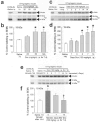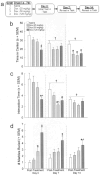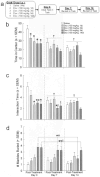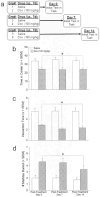Anxiety-like behavior of mice produced by conditional central expression of the HIV-1 regulatory protein, Tat
- PMID: 24352568
- PMCID: PMC4020990
- DOI: 10.1007/s00213-013-3385-1
Anxiety-like behavior of mice produced by conditional central expression of the HIV-1 regulatory protein, Tat
Abstract
Rationale: Human immunodeficiency virus (HIV) infection is associated with substantial increases in generalized anxiety. The HIV regulatory protein, transactivator of transcription (Tat), has been implicated in the neuropathogenesis related to HIV-1 infection. However, direct examination of the effect of Tat on behavioral measures of anxiety has not been demonstrated.
Objective: To identify whether expression of the Tat1-86 protein exerts dose-dependent and persistent anxiety-like effects in a whole animal model, the GT-tg bigenic mouse.
Methods: GT-tg mice and C57BL/6J controls were administered doxycycline in a dose- (0, 50, 100, or 125 mg/kg, i.p., for 7 days) or duration- (100 mg/kg, i.p., for 0, 1, 3, 5, or 14 days) dependent manner to induce Tat1-86 in brain. Mice were assessed for anxiety-like behavior in an open field, social interaction, or marble burying task 0, 7, and/or 14 days later. Central expression of Tat1-86 protein was verified with Western blot analyses.
Results: Doxycycline produced no effects on C57BL/6J controls that lacked the Tat1-86 transgene. Among GT-tg mice, doxycycline (100 mg/kg for 3, 5, or 7 days) significantly increased anxiety-like behavior in all tasks, commensurate with enhanced Western blot labeling of Tat1-86 protein in brain, displaying optimal effects with the 7-day regimen. Greater exposure to doxycycline (either 125 mg/kg for 7 days or 100 mg/kg for 14 days) impaired locomotor behavior; whereas lower dosing (below 100 mg/kg) produced only transient increases in anxiety-like behavior.
Conclusions: Expression of HIV-1-Tat1-86 in GT-tg mouse brain produces exposure-dependent, persistent increases in anxiety-like behavior.
Conflict of interest statement
Figures




Similar articles
-
Progesterone protects normative anxiety-like responding among ovariectomized female mice that conditionally express the HIV-1 regulatory protein, Tat, in the CNS.Horm Behav. 2014 May;65(5):445-53. doi: 10.1016/j.yhbeh.2014.04.001. Epub 2014 Apr 12. Horm Behav. 2014. PMID: 24726788 Free PMC article.
-
Exposure to HIV-1 Tat in brain impairs sensorimotor gating and activates microglia in limbic and extralimbic brain regions of male mice.Behav Brain Res. 2015 Sep 15;291:209-218. doi: 10.1016/j.bbr.2015.05.021. Epub 2015 May 22. Behav Brain Res. 2015. PMID: 26005128 Free PMC article.
-
Effects of conditional central expression of HIV-1 tat protein to potentiate cocaine-mediated psychostimulation and reward among male mice.Neuropsychopharmacology. 2014 Jan;39(2):380-8. doi: 10.1038/npp.2013.201. Epub 2013 Aug 15. Neuropsychopharmacology. 2014. PMID: 23945478 Free PMC article.
-
Doxycycline-inducible and astrocyte-specific HIV-1 Tat transgenic mice (iTat) as an HIV/neuroAIDS model.J Neurovirol. 2018 Apr;24(2):168-179. doi: 10.1007/s13365-017-0598-9. Epub 2017 Nov 15. J Neurovirol. 2018. PMID: 29143286 Free PMC article. Review.
-
Signatures of HIV-1 subtype B and C Tat proteins and their effects in the neuropathogenesis of HIV-associated neurocognitive impairments.Neurobiol Dis. 2020 Mar;136:104701. doi: 10.1016/j.nbd.2019.104701. Epub 2019 Dec 11. Neurobiol Dis. 2020. PMID: 31837421 Review.
Cited by
-
Humanized Mice for Infectious and Neurodegenerative disorders.Retrovirology. 2021 Jun 5;18(1):13. doi: 10.1186/s12977-021-00557-1. Retrovirology. 2021. PMID: 34090462 Free PMC article. Review.
-
HIV-1 Tat promotes age-related cognitive, anxiety-like, and antinociceptive impairments in female mice that are moderated by aging and endocrine status.Geroscience. 2021 Feb;43(1):309-327. doi: 10.1007/s11357-020-00268-z. Epub 2020 Sep 17. Geroscience. 2021. PMID: 32940828 Free PMC article.
-
Conditional Tat protein brain expression in the GT-tg bigenic mouse induces cerebral fractional anisotropy abnormalities.Curr HIV Res. 2015;13(1):3-9. doi: 10.2174/1570162x13666150126125244. Curr HIV Res. 2015. PMID: 25619988 Free PMC article.
-
The effects of HIV-1 regulatory TAT protein expression on brain reward function, response to psychostimulants and delay-dependent memory in mice.Neuropharmacology. 2016 Oct;109:205-215. doi: 10.1016/j.neuropharm.2016.06.011. Epub 2016 Jun 15. Neuropharmacology. 2016. PMID: 27316905 Free PMC article.
-
Allopregnanolone and neuroHIV: Potential benefits of neuroendocrine modulation in the era of antiretroviral therapy.J Neuroendocrinol. 2022 Feb;34(2):e13047. doi: 10.1111/jne.13047. Epub 2021 Oct 14. J Neuroendocrinol. 2022. PMID: 34651359 Free PMC article. Review.
References
-
- Bing EG, Burnam MA, Longshore D, Fleishman JA, Sherbourne CD, London AS, Turner BJ, Eggan F, Beckman R, Vitiello B, Morton SC, Orlando M, Bozzette SA, Ortiz-Barron L, Shapiro M. Psychiatric disorders and drug use among human immunodeficiency virus-infected adults in the United States. Arch Gen Psychiatry. 2001;58:721–728. doi: 10.1001/archpsyc.58.8.721. - DOI - PubMed
Publication types
MeSH terms
Substances
Grants and funding
LinkOut - more resources
Full Text Sources
Other Literature Sources
Medical
Miscellaneous

